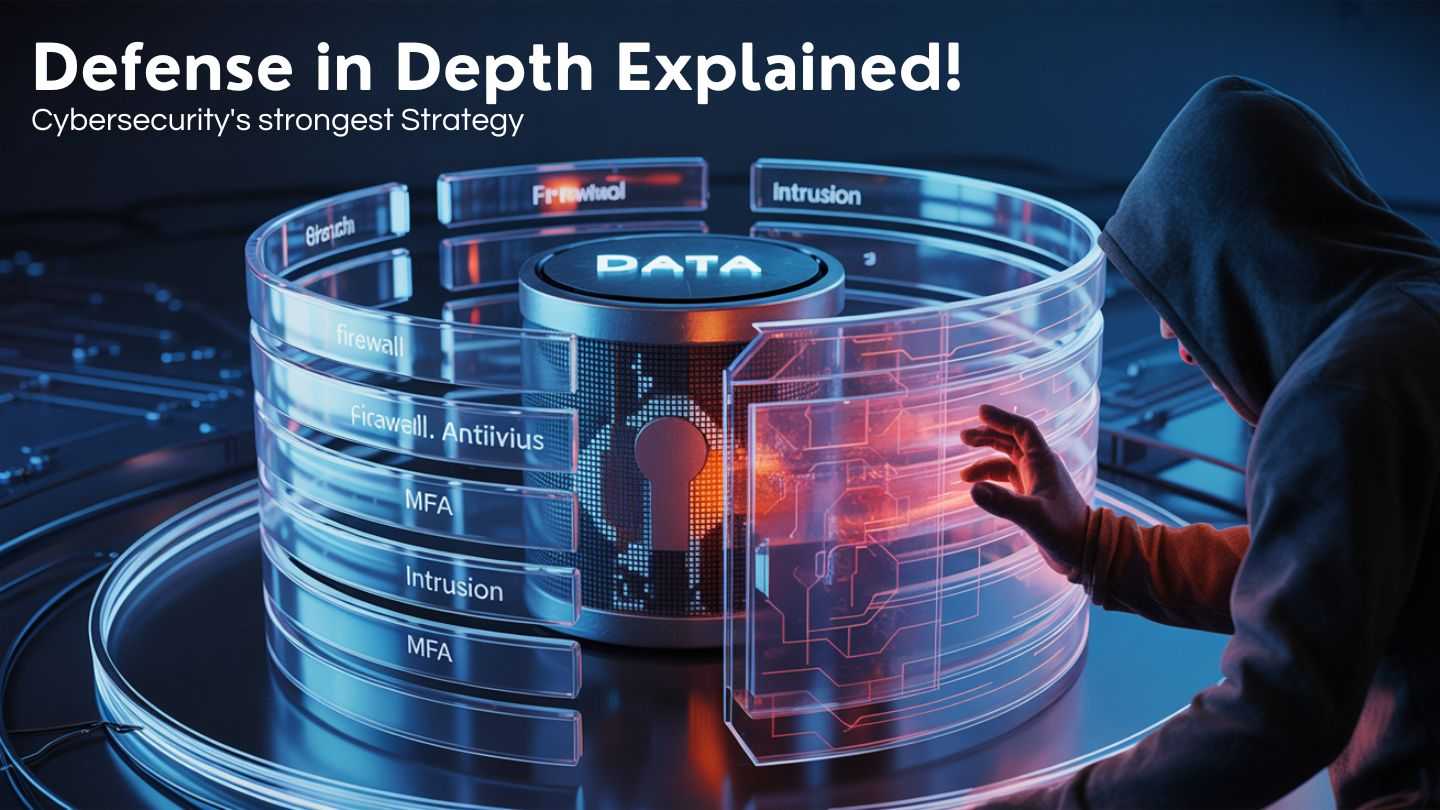Defense in Depth (DiD) in cybersecurity is a strategy that uses multiple layers of security to protect against breaches. It doesn’t rely on just one defense but combines different measures to keep threats at bay. This blog will show you what defense in depth is in cybersecurity, why it’s essential, and how to put it into practice.
Key Takeaways
- Defense in Depth (DiD) utilizes multiple layers of security controls, integrating technical, administrative, and physical measures to effectively reduce cybersecurity risks.
- Modern DiD strategies have evolved from traditional perimeter defenses to incorporate advanced measures such as behavioral analytics and Zero Trust principles, adapting to sophisticated cyber threats.
- Key components of a DiD strategy include network segmentation, endpoint detection and response (EDR), and privileged access management, all aimed at bolstering an organization’s security posture against various cyber threats.
Understanding Defense in Depth (DiD)
Defense in Depth (DiD) is a strategic approach to cybersecurity that minimizes risks through multiple layers of security. Unlike traditional security measures that rely on a single line of defense, DiD employs various security controls working in tandem to protect IT systems and data. The importance of this approach lies in its ability to significantly reduce the likelihood of breaches by layering security processes. Think of it as a medieval castle with multiple walls, each serving as a barrier to potential invaders.
The Evolution of Defense in Depth Strategies
Defense in Depth strategies originated with traditional perimeter-based security models. These models concentrated on constructing a robust barrier around the network, assuming threats would only emerge externally. Modern cyber threats, being more sophisticated, can exploit multiple entry points, making a single security layer insufficient. The transition from perimeter security to a layered defense model has been spurred by the rise in cloud technology adoption and remote work.
Current Defense in Depth strategies incorporate multiple security layers to guard against complex and evolving cyber threats. Components such as behavioral analytics and cloud workload protection are now integral to contemporary DiD strategies.
Core Elements of a Defense in Depth Strategy
A comprehensive Defense in Depth strategy includes three core elements:
- Administrative controls, including security policies and employee training, are crucial in mitigating cybersecurity risks.
- Physical security.
- Technical controls.
These elements collaborate to form a holistic security framework addressing various organizational security needs.
Physical security measures are essential for safeguarding tangible assets and should not be neglected. Technical controls, like firewall rules and intrusion detection systems, are vital for securing digital environments, and information security physical controls, including considerations for mobile devices, web application firewalls, multiple security measures, data encryption, and security risks, are also important in this comprehensive approach to security.
We will now explore each of these core elements to understand their specific roles and contributions to a robust Defense in Depth strategy.
Administrative Controls
Administrative controls form the backbone of any Defense in Depth strategy. These controls encompass security policies, procedures, and employee security awareness training programs that mitigate cybersecurity risks. Training employees in security awareness is particularly important as it fosters a culture of vigilance and significantly reduces risks from human error and social engineering. Phishing schemes, which deceive users into revealing sensitive information, can be effectively mitigated through user education and email filtering technologies.
Phishing attacks remain a prevalent threat; however, layered security measures enable organizations to detect suspicious activities and alert users before any damage occurs. Instilling a strong security culture and ensuring all employees are aware of potential threats, administrative controls establish the first line of defense against cyber threats.
Physical Security
Physical security measures, often overlooked, are a crucial component of a Defense in Depth strategy. These measures include:
- Restricting access with security/e-cards and implementing access control systems to secure physical areas.
- Monitoring physical environments with surveillance systems, like security cameras, to detect and deter unauthorized activities.
- Securing physical access to IT systems, such as locking server rooms, is crucial to protect sensitive information and infrastructure.
Physical security is not just about preventing unauthorized entry; it also involves safeguarding critical assets from physical threats. Integrating physical security measures into the overall security strategy ensures that tangible assets are well-protected, adding another layer of defense against potential breaches.
Technical Controls
Technical controls comprise the tools and technologies that protect digital environments from various threats. Intrusion detection systems, for example, monitor real-time traffic for potential threats, aiding in the prompt identification and mitigation of attacks. Implementing these systems enhances an organization’s overall security posture and enables an effective response to anomalies.
Layered Security vs. Defense in Depth

While layered security and Defense in Depth are often used interchangeably, they are not the same. Layered security can be seen as a subset of Defense in Depth, focusing on specific products for one security function. Conversely, Defense in Depth employs a comprehensive strategy that integrates various security measures to address all aspects of an organization’s security needs.
Recognizing the differences between these approaches helps organizations implement a more effective and comprehensive security framework.
Key Components of Defense in Depth
Several key components constitute the foundation of a Defense in Depth strategy:
- Network segmentation: Dividing a network into smaller segments to control traffic more effectively and limit the spread of cyber threats.
- Endpoint Detection and Response (EDR) solutions: Crucial for detecting and responding to malicious activities on end user devices.
- Privileged Access Management (PAM) solutions: Aid in managing privileged accounts and minimizing the risk of unauthorized access to sensitive data.
Integrating these components enables organizations to create a multi-layered defense that addresses various attack vectors and enhances overall security. We will now explore each of these components in more detail.
Network Segmentation
Network segmentation improves security by restricting traffic flow between different segments. Effective segmentation helps contain malware spread within a single network area, preventing it from affecting the entire network. Micro-segmentation provides detailed controls over traffic flow, enabling tailored security policies for specific applications.
Endpoint Detection and Response (EDR)
EDR solutions are crucial for actively monitoring endpoints for signs of malicious activity, detecting and identifying malicious activity, and providing rapid response capabilities. These tools monitor endpoints for suspicious activities and facilitate rapid incident response, including the detection of anomalous or malicious behaviors. Continuous real-time monitoring of endpoint activities allows organizations to swiftly detect and respond to suspicious actions.
Without EDR solutions, organizations may have a flat security posture, underscoring the importance of comprehensive detection and response. EDR tools play a crucial role in ensuring that endpoints, often the first targets of cyberattacks, are well-protected and monitored.
Privileged Access Management Solutions
Effective management of privileged accounts can markedly reduce the risk of unauthorized access to critical organizational assets. Privileged accounts are special user accounts with elevated access rights to perform tasks that regular users cannot. To effectively manage these accounts, organizations must assign users appropriately, minimizing the risk of unauthorized access to sensitive information and adhering to the principle of least privilege.
Implementing Defense in Depth Strategies
Several key steps are involved in implementing a defense in depth strategy. First, assess current security measures by evaluating existing vulnerabilities and security controls to ensure adequacy. Next, integrate new tools by researching available security products and best practices to implement defense and ensure they complement the overall strategy.
Finally, apply continuous monitoring to detect and respond to threats effectively, ensuring that established security measures are consistently evaluated for efficacy.
Following these steps enables organizations to build a robust Defense in Depth strategy that addresses unique security needs and protects against evolving cyber threats.
Assessing Current Security Measures
Evaluating current security measures is a critical first step in implementing a Defense in Depth strategy. Segmenting a network helps isolate sensitive data, limiting the impact of a security breach. Regular auditing of privileged account activities helps identify and mitigate potential risks.
Evaluating existing vulnerabilities and security controls allows organizations to identify gaps in their security posture and take proactive measures to address them. This ensures the Defense in Depth strategy’s foundation is solid and effective.
Integrating New Tools
Choosing the right heterogeneous security technologies can significantly enhance an organization’s Defense in Depth strategy. When selecting security technologies, it is important to consider their compatibility with existing systems to ensure seamless integration.
By carefully selecting and integrating new tools, organizations can strengthen their overall security posture and ensure that all security measures work together harmoniously. This enhances the effectiveness of the Defense in Depth strategy and provides comprehensive protection against cyber threats.
Continuous Monitoring
Continuous monitoring is essential for maintaining ongoing security in a Defense in Depth strategy. By detecting threats early, continuous monitoring helps limit damage and ensure business continuity. Effective management of privileged accounts includes monitoring activities to prevent unauthorized access to critical systems.
By continuously monitoring all security layers, organizations can promptly detect and respond to threats, ensuring that their security measures remain effective over time. This proactive approach is crucial for maintaining a robust and resilient Defense in Depth strategy.
Benefits of Defense in Depth

A Defense in Depth strategy offers numerous benefits, including:
- Early threat detection and prompt responses to mitigate potential breaches.
- Implementation of multi-layered security measures that increase redundancy, making it harder for attackers to penetrate defenses.
- Decreased likelihood of a total system failure by ensuring there are no singular points of vulnerability.
Additionally, adopting a Defense in Depth strategy aids in meeting industry compliance requirements, demonstrating a commitment to protecting sensitive information.
Defense in Depth for Cloud Environments
Cloud adoption introduces new attack vectors, such as misconfigurations, compromised credentials, and unsecured APIs. Implementing a defense in depth strategy is crucial for companies utilizing cloud services to protect cloud workloads and defend against these new threats. Traditional perimeter-based security is inadequate for modern demands, as it assumes internal network safety and overlooks threats from employee devices. Additionally, cloud security measures must be integrated to address these vulnerabilities effectively.
Common Cybersecurity Threats Addressed by Defense in Depth
Defense in Depth strategies are designed to address a wide range of cybersecurity threats. Insider attacks, which can be challenging to detect, are mitigated through a layered approach that includes monitoring user behavior and access control. By employing multiple security layers, organizations can make it harder for attackers to succeed even if one measure fails.
Final Thoughts on Defense in Depth (DiD)
Defense in Depth (DiD) is a robust cybersecurity approach that relies on multiple layers of protection to guard against evolving threats. By transitioning from perimeter-based strategies to dynamic, layered defenses, organizations can stay resilient in the face of increasingly sophisticated cyberattacks. A well-implemented DiD strategy ensures that IT systems and data remain secure, even when individual security measures are breached.
At IntegriCom, we specialize in helping businesses strengthen their security posture with tailored Defense in Depth strategies. Our comprehensive cyber security services in Atlanta provide proactive solutions to protect your organization from cyber threats. Let us support your business in staying ahead of potential risks, ensuring your systems and data remain secure while you focus on growth.
Frequently Asked Questions
What is Defense in Depth (DiD)?
Defense in Depth (DiD) is a cybersecurity approach that utilizes multiple layers of security measures, integrating technical, administrative, and physical controls to create a robust defense framework. This strategy effectively minimizes risks to IT systems and data.
How has Defense in Depth evolved over time?
Defense in Depth has progressed from simple perimeter-based security to sophisticated layered defense strategies that integrate behavioral analytics and cloud protection, reflecting the necessity to combat increasingly complex cyber threats. This evolution underscores the importance of adapting security measures in an ever-changing digital landscape.
What are the core elements of a Defense in Depth strategy?
The core elements of a Defense in Depth strategy encompass administrative controls, physical security measures, and technical controls. Each layer collaborates to enhance overall security and mitigate risks effectively.
How can organizations implement a Defense in Depth strategy?
Organizations can implement a Defense in Depth strategy by assessing their current security measures, integrating new tools, and engaging in continuous monitoring. This comprehensive approach helps ensure all security layers are effective against evolving threats.
What are the benefits of adopting a Defense in Depth strategy?
Adopting a Defense in Depth strategy enhances overall security by enabling early threat detection, increasing redundancy, and ensuring compliance with industry standards. This layered approach makes it more challenging for attackers to breach defenses and minimizes the risk of complete system failure.


